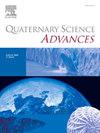Formation of an epigenetic gorge following a giant landslide damming in Kyirong River of the central Himalayas
IF 2.2
Q2 GEOGRAPHY, PHYSICAL
引用次数: 0
Abstract
In tectonically active mountainous regions, large-scale landslide damming events have profound impacts on long-term fluvial landforms, such as river diversion and formation of epigenetic gorges. Here, we investigate morphometric and sedimentological evidence of an ancient large-scale landslide in the Kyirong River basin located in the central Himalayas. The ancient Kyirong landslide completely blocked the river, causing overtopping at the lowermost part of the dam crest. The river then progressively incised through the landslide deposits and the underlying bedrock, carving out the ∼300-m-deep Kyephu Gorge within the original bedrock valley walls. Unlike the conventional formation of epigenetic gorges, the new river channel of the Kyirong River is located closer to the landslide wall compared to the original channel.This unique formation model is the result of the combined effects of the landslide movement process and the distinctive topography. Through remote sensing image interpretation, field surveys, sediment layer analysis, and geomorphological parameter calculations, this study reconstructs the motion process of the Kyirong landslide and its subsequent effects on the river system. The Kyirong landslide is identified as a late Quaternary event, corresponding to a river incision rate of over 14.2 mm/year. The landslide event has caused significant changes in local geomorphological features, reshaping the evolution of the river. This study provides a specific case, demonstrating that in tectonically active regions, landslide events play a direct role in controlling the evolution of river landforms.
喜马拉雅山脉中部的基隆河发生了巨大的山体滑坡,形成了一个后生峡谷
在构造活跃的山区,大规模的滑坡筑坝事件对河流改道和后生峡谷的形成等长期河流地貌有着深远的影响。在此,我们研究了位于喜马拉雅山脉中部的基隆江流域古代大型滑坡的形态和沉积学证据。古老的基荣滑坡完全阻塞了河流,造成了大坝最底部的溢流。然后,河流逐渐穿过滑坡沉积物和下面的基岩,在原始基岩山谷壁上雕刻出约300米深的凯富峡谷。与传统的后成峡谷不同,基荣江新河道比原河道更靠近滑坡壁。这种独特的形成模式是滑坡运动过程和独特地形共同作用的结果。通过遥感影像解译、野外调查、沉积物层分析和地貌参数计算,重建了基荣滑坡的运动过程及其对水系的后续影响。基荣滑坡为晚第四纪事件,对应于河流切割速率超过14.2 mm/年。山体滑坡事件使当地地貌特征发生了重大变化,重塑了河流的演变。本研究提供了一个具体的案例,表明在构造活跃地区,滑坡事件对河流地貌的演变起着直接的控制作用。
本文章由计算机程序翻译,如有差异,请以英文原文为准。
求助全文
约1分钟内获得全文
求助全文
来源期刊

Quaternary Science Advances
Earth and Planetary Sciences-Earth-Surface Processes
CiteScore
4.00
自引率
13.30%
发文量
16
审稿时长
61 days
 求助内容:
求助内容: 应助结果提醒方式:
应助结果提醒方式:


